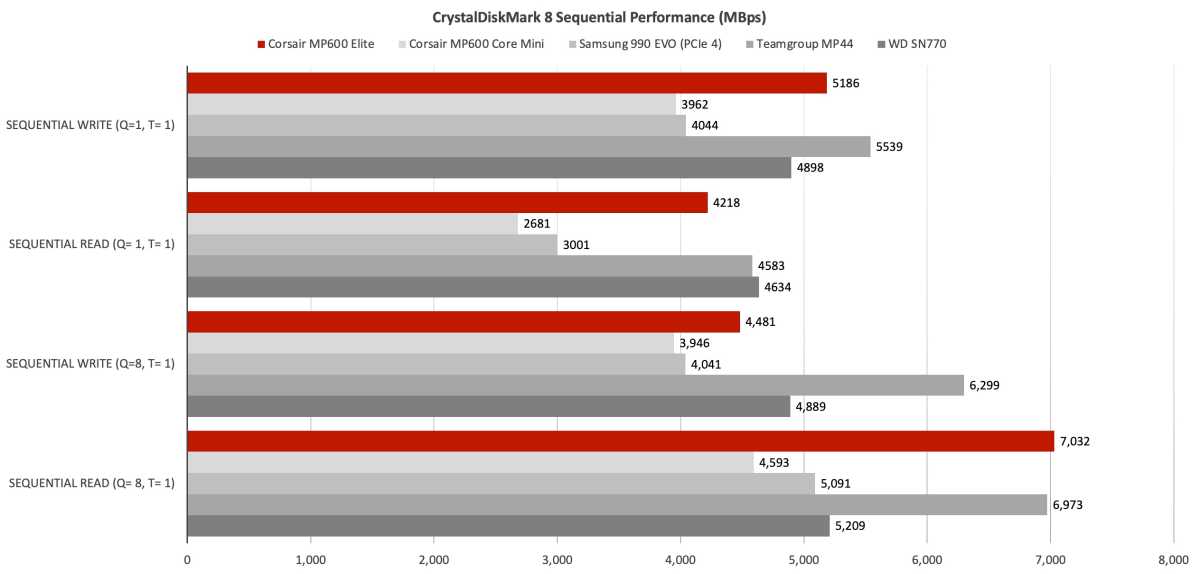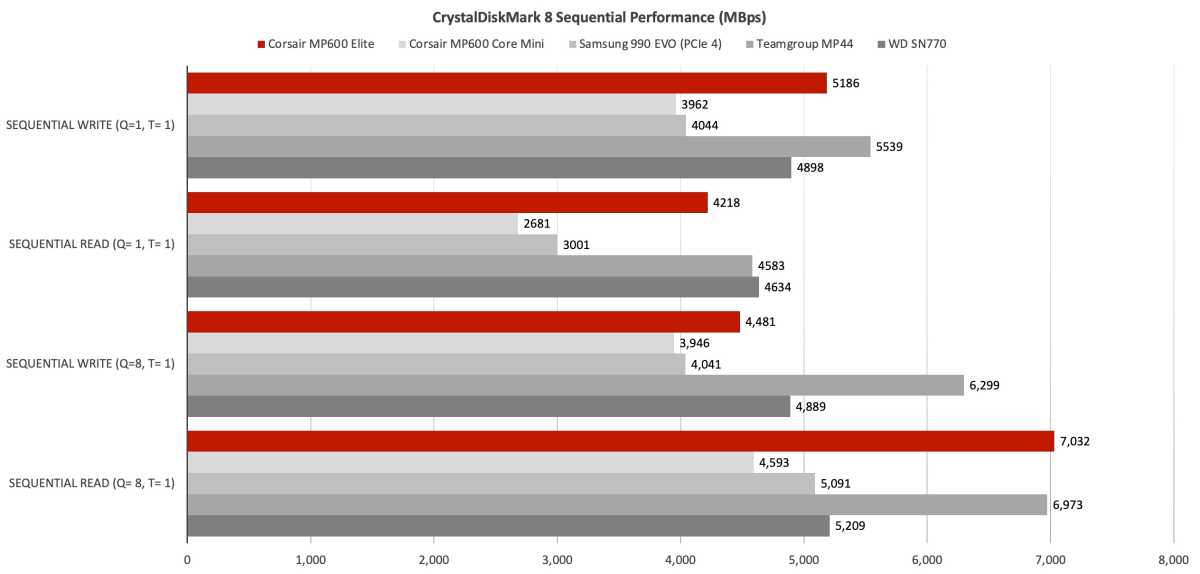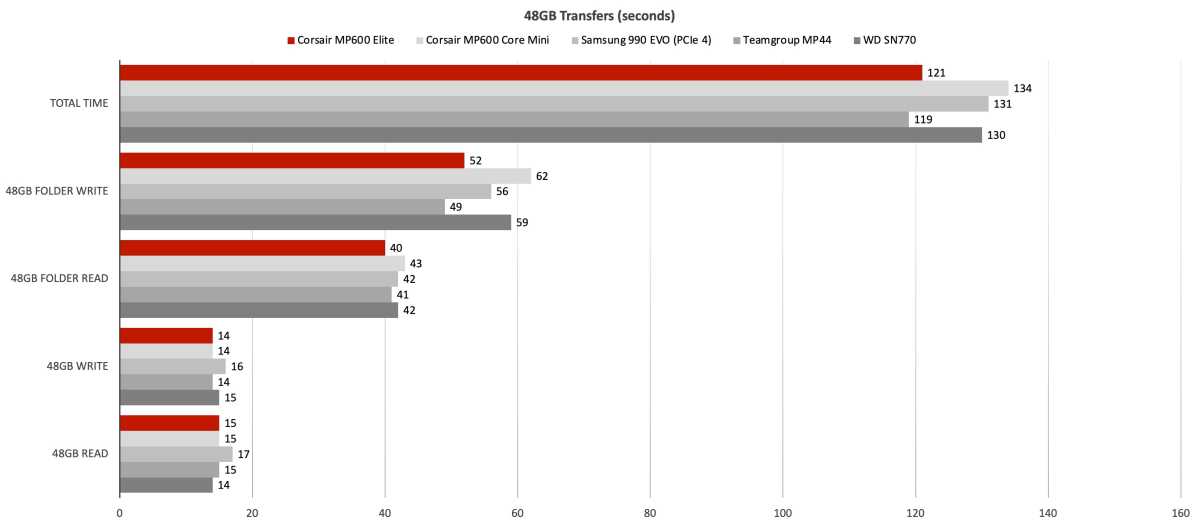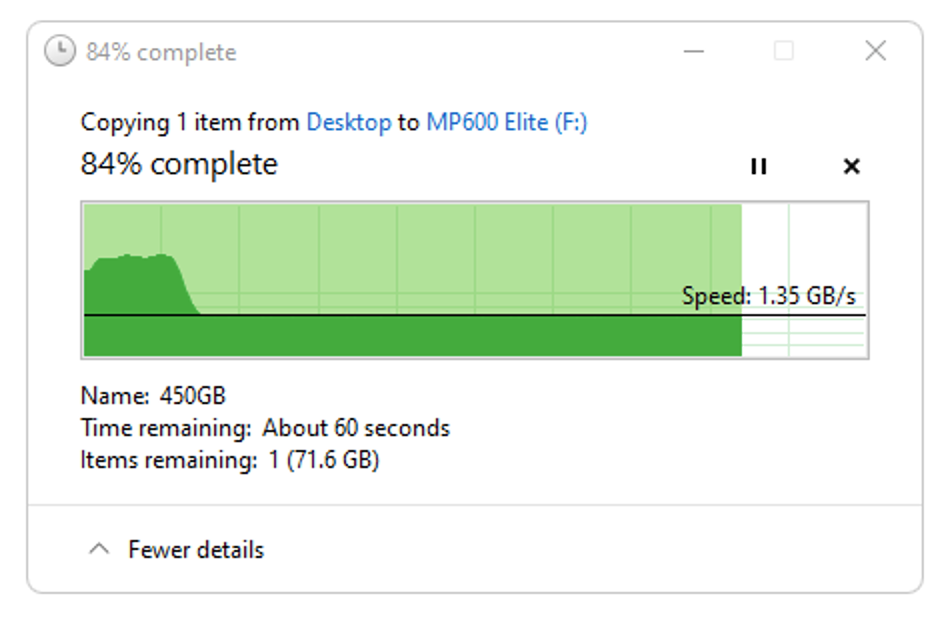Expert’s Rating
Pros
- Good overall performance
- Great random performance for an HMB design
- Affordable with a good warranty and TBW rating
Cons
- Runs out of secondary cache more quickly than most
Our Verdict
The Corsair MP600 Elite ranks very high performance-wise among the host memory buffer (HMB) SSDs we’ve tested. It’s worthy of your NVMe 4.0 short list if you’re not continually writing very large files.
Price When Reviewed
1TB: $90/$95 (w/heatsink) I 2TB: $165/$170 (w/heatsink)
Corsair’s MP600 Elite NVMe SSD is affordable, fast with smaller data sets and random writes, and is available with a beefy heatsink to eliminate thermal throttling under heavy loads. That heatsink is also unusually affordable, incurring only a $5 surcharge.
The slightly parsimonious secondary caching on this host memory buffer (HMB) design limits the drive’s performance if you write more than 50GB of large files, but the 1.3GBps native write rate is light years better than that of QLC designs.
Further reading: See our roundup of the best PCIe 4.0 SSDs to learn about competing products.
What are the Corsair MP600 Elite’s features?
I’ve already clued you in about the host memory buffer (aka, DRAM-less) design and the heatsink. Beyond that, the MP600 Elite is a 2280 (22mm wide, 80mm long) PCIe 4.0 x4, NVMe 1.4, M.2 SSD. The controller is a Phison PS5027-E27-61 and the NAND is layered TLC.
Corsair warranties the MP600 Elite for five years with a 600TBW (terabytes that may be written) per 1TB of capacity rating. That’s par for the course on both counts.
How much does the Corsair MP600 Elite cost?
The Corsair MP600 Elite is available with/without the heat sink in 1TB ($90/$95) and 2TB ($165/$170) flavors. If you’re looking for a heat sink, a $5 surcharge is a pittance. Most vendors charge $10 or more.
The heatsink versions of the MP600 Elite are a particular bargain. Nice job, Corsair.
How fast is the Corsair MP600 Elite?
While the 2TB MP600 Elite Corsair sent us for testing didn’t set any records, it benchmarks in the upper echelon of HMB SSDs that we’ve tested — 6th out of 15 drives.
However, the somewhat meager 50GB allotment of secondary cache (the TLC written as SLC, one bit at a time instead of three) held the drive back in our real-world tests, though not drastically thanks to a still somewhat lively off-cache (TLC/3-bit) native write rate of 1.35GBps.
As you can see below, the MP600 Elite was very sprightly in CrystalDiskMark 8’s sequential testing. Faring quite well compared to its MP600 Core Mini cousin, the brand-new Samsung 990 EVO, Teamgroup’s MP44, and the WD SN770. All are HMB designs.

The MP600 Elite also proved more than worthy in random 4K performance, something HMB designs aren’t necessarily famous for.

The MP600 Elite was very fast at our 48GB transfers — when given time to breathe. My first run writing the 48GB single file took 32 seconds rather than the 14 shown in the chart — apparently because I failed to let the drive recover sufficiently from the the 48GB file and folder write. But it does point out the limits of the 50GB cache.

Also highlighting the limited 50GB secondary cache was a write rate drop from 3.2GBps to the aforementioned 1.35GBps during the 450GB write. While not optimal, it’s hardly the tragic 150MBps you’ll see from some QLC designs under similar circumstances.

Below you can see exactly when the MP600 Elite ran out of secondary cache.

All in all, the MP600 Elite, while not taking the top spot, did Corsair proud. Avoid it for super heavy, continuous workloads, but short-list it otherwise.
Should you buy the Corsair MP600 Elite?
If you’re looking for good everyday performance without breaking the bank, then yes, consider the Corsair MP600 Elite for purchase. The heatsink versions are a particular bargain. Nice job, Corsair.
How we test
Drive tests currently utilize Windows 11 (22H2) 64-bit running on an X790 (PCIe 5.0) motherboard/i5-12400 CPU combo with two Kingston Fury 32GB DDR5 modules (64GB of memory total). Intel integrated graphics are used. The 48GB transfer tests utilize an ImDisk RAM disk taking up 58GB of the 64GB total memory. The 450GB file is transferred from a Samsung 990 Pro 2TB, which also contains the operating system.
Each test is performed on a newly formatted and TRIM’d drive so the results are optimal. Note that as any drive fills up, performance will decrease due to less NAND for secondary caching, and other factors.
The performance numbers shown apply only to the drive we were shipped as well as the capacity tested. SSD performance can vary by capacity due to more or fewer chips to read/write across and the amount of NAND available for secondary caching (writing TLC/QLC as SLC). Vendors also occasionally swap components. If you ever notice a large discrepancy between the performance you experience and that which we report (systems being roughly equal), by all means—let us know.


